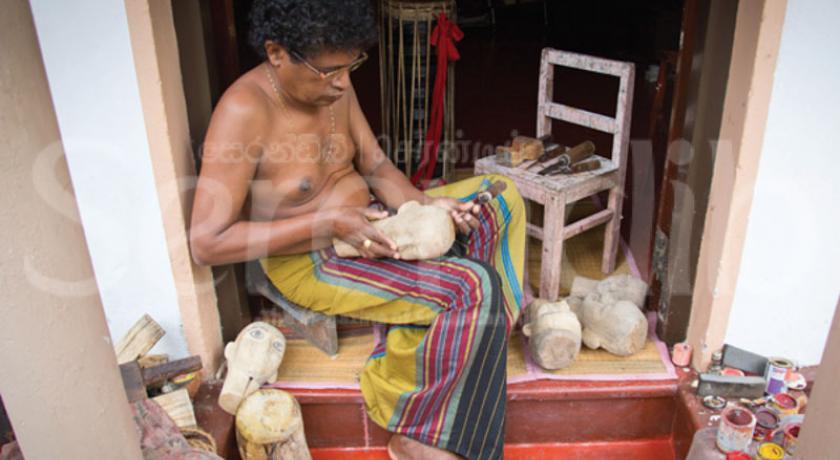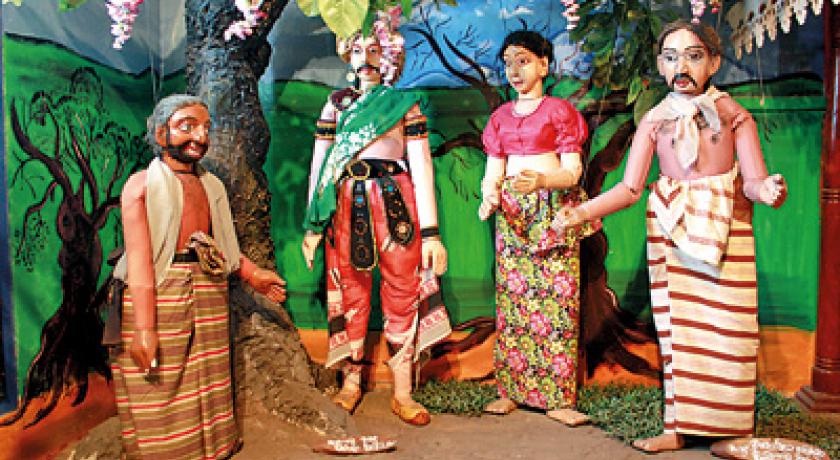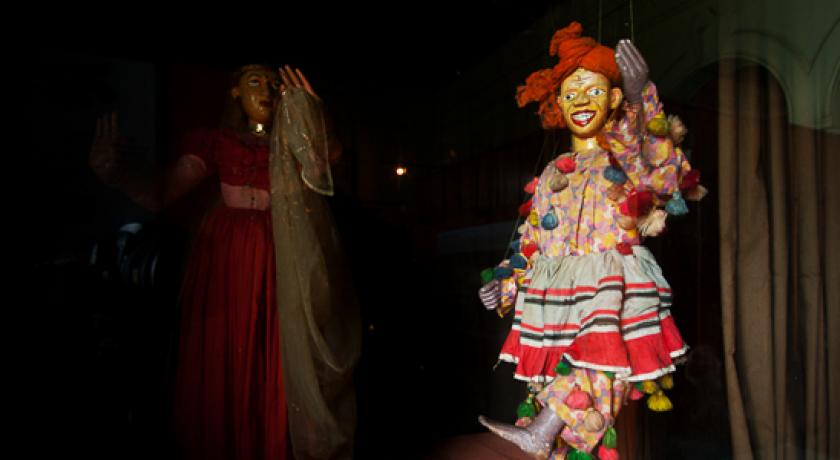Description
Ambalangoda in the south coast of Sri Lanka is renowned as a treasury of traditional Sri Lankan folk art, folk dramas and ancient rituals passed down from generation to generation. The town is made famous for devil dancing employing masks; mask making, puppet show showcasing important aspects of the local culture. The traditional puppeteers of Ambalangoda are well versed in Nadagam dance forms as well. The English word ‘’puppet’’ is used as ‘’Rukada’’ in Sinhala language. Podisirina Gurunnanse was the first puppeteer in Sri Lanka to bring credit to the country on the folk art of puppetry. He is credited with introducing not only screens to the Sri Lankan puppet stage, but also the popular Nango Hami and Sellan Lama characters who sometimes perform introductory acts to the main play. Since then, Gate Mudalier Solomon Dias Bandaranaike, Mudalier N. Wickramaratne, Dr. Hewavitharana, F.R. Senanayake, P. de S. Kularatne and Professor G.P. Malalasekara were some of the prominent people who recognised the value of the traditional folk art of puppetry. They never failed to extend their cooperation to promote puppetry in Sri Lanka. With the participation of an efficient group of puppeteers from Ambalangoda, Podisirina Gurunnanse formed the "Dakshina Lanka Puppeteers. There are several types of puppets in Sri Lanka. This classification is made in terms of the media and the nature of playing. Among the different types of puppets. Thread puppet (Nool rukada), Club puppet (Riti rukada), Shadow puppet (Sevaneli rukada), Hand puppet (Ath rukada) and Finger puppet (Angili rukada) are very famous. They can be classified as two – dimensional and three – dimensional in terms of their visual angle. The classification of puppet is mainly dependent on the versatility of the artist or player. According to tradition, when creating wooden puppets, the tree of Kaduru or Rukattthana is used and the form of the puppet is created after making proper treatments for dried parts of the timber. In the creation of human characters, the standard size of the man is taken.
In addition, the other two methods called ‘’Prathima Kala’’ and ‘’Bali Kala’’ are also used in creating different types of characters in relation to puppets. When decorating the puppet characters, flexible points of organs are taken into consideration, and they are dressed properly and operated with the assistance of key boads connected with thread.The players or artists are to operate the puppets of different characters and other supportive services such as lighting the stage, making dialogue, supplying music and decorating the stage need to be undertaken in coherent manner. Finally it can be concluded that the puppetry in Sri Lanka has been developed to the present status with the influence of South Indian, Asian and Western traditions while conserving the values and traditions which are identical to domestic culture. Therefore, it is very important to popularize the puppetry among new generations, since it is traditional form of folk art that can be appreciated by the people belong to any age category from child to adult. Many travelers come to Colombo and miss this hot spot of Sri Lankan tourism, the Puppet museum Dehiwala. The puppet museum arguably most interested in both local and foreign travelers. There are few galleries of this museum.The first gallery is about ‘Diktala Kalagola’ Story. In addition to the story the main character was Kalagola, the servant of Diktala’s father. Diktala was a young aged beautiful woman. Kalgola was a ugly, short and seemed like a dwarf compared to the Dikthala. Further the story of Madduma Bandara, Wessanthara jathakaya, Vidura Jathakaya, and Saliya Ashokamala story is displayed in other galleries in the museum.It may feel awesome of hearing the story behind the puppets. I’m sure, if someone have seen the story of Wessanthara jathakaya in the puppet gallery, they will not prefer it from the Television. The gallery of traditional masks of Sri Lanka is yet another enormous gallery, recently restored in the Puppets museum.Unfortunately there are only 3 families who know about all the techniques beyond the wooden Puppetry industry in Ambaalangoda. But they want to rescue this tradition rather than losing it.
So that most of these are made by the artists from Ambalangoda. Unfortunately there are only 3 families who know about all the techniques beyond the wooden Puppetry industry in Ambaalangoda. But they want to rescue this tradition rather than losing it. The mask of King Mahasammatha (the first king of the world), gara yaka, Maname masks, Riri Yaka and so on are exhibited in this gallery. They are giant, curious and beautiful. Various puppets are hanged on rafting can be touched and enjoyed. Marvelous clothing painted with fabrics and sewn with sequins and beads will astonish you.By the way the television has dominated to lose the Puppet art from the society. Therefore it is a good decision to secure this traditional heritage. Thus the value of the puppetry has been lost until recently.
Source: http://www.news.lk/news/sports-travel/item/7852-illumination-of-sri-lankan-folk-art-puppets
Address
Puppet Museum Srilanka Srilanka
Sri Lanka
Lat: 6.861422539 - Lng: 79.866439819






